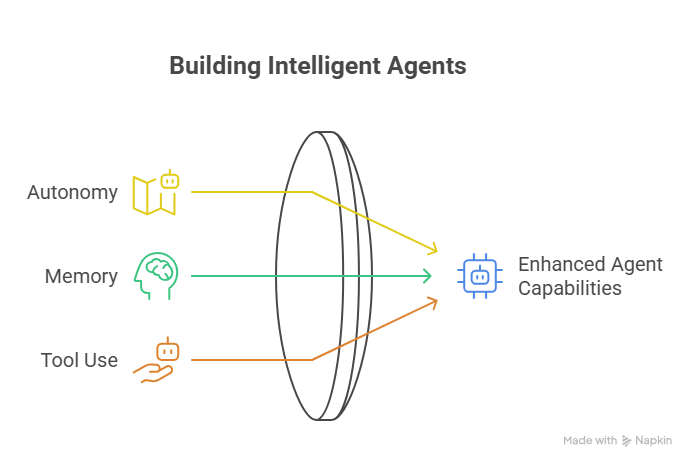Think about your current product team.
Now imagine adding someone who never sleeps, never forgets, doesn’t need onboarding, and can manage tasks across tools without breaking a sweat.
Sounds like sci-fi?
Not anymore.
Because that’s exactly what’s becoming possible with Agentic AI.
Unlike traditional AI tools that wait for instructions, Agentic AI systems operate with autonomy. They don’t just respond to prompts; they pursue outcomes. They reason. They plan. They follow through. In some cases, they’re already outperforming entry-level team members in speed, scale, and consistency.
If you’re running a business, building software, or just trying to do more with fewer resources, this is a shift worth paying attention to. Because the next leap in productivity won’t come from adding more tools; it’ll come from adding agents.
In this post, we’ll explore:
- What Agentic AI actually means (no fluff, we promise)
- Why it’s different from the AI you’re used to
- What it can do for your business today
- And how to know if you’re ready for it
Let’s get started.
What Is Agentic AI?
Agentic AI refers to intelligent systems that can act independently to achieve a defined goal.
Where traditional AI needs clear, task-level instructions, Agentic AI takes a broader objective and figures out how to achieve it. These agents are capable of decision-making, tool usage, and iterative learning, all without constant human input.
There are three core traits that define Agentic AI:

Autonomy
Agents make choices and carry out actions on their own. You give them a goal. They decide how to get there.
Memory
They retain context from past interactions. This enables them to learn, adapt, and improve over time.
Tool Use
Agents aren’t confined to a single interface. They can interact with APIs, databases, spreadsheets, calendars, CRMs, and anything required to complete the task.
In short: this isn’t just smarter AI. It’s action-oriented intelligence.
Why Now? Why Agentic AI Is Suddenly Everywhere
Agentic AI isn’t entirely new. Researchers and startups have been exploring autonomous systems for years. But only recently have the conditions been right for real-world adoption.
There are four main reasons for this shift:
1. Smarter models
Large language models like GPT-4, Claude, and Gemini can now reason across multiple steps, hold context, and make non-trivial decisions. That’s the core thinking engine for any agent.
2. Real memory
Early AI tools forgot everything the moment a conversation ended. Modern agents use vector databases and embeddings to store long-term memory, allowing them to learn, reflect, and build experience over time.
3. Easier integration
Thanks to frameworks like LangChain, CrewAI, AutoGen, and ReAct, it’s never been easier to plug agents into real systems, from your marketing stack to your internal APIs.
4. Business pressure
Let’s be honest: everyone wants to do more with fewer resources. Agentic AI isn’t just a cool idea, it’s a way to reclaim time, scale operations, and free up your team for more strategic work.
So What Can an AI Agent Actually Do?
Short answer: a lot.
Long answer: It depends on where your team is wasting time right now.
Here are some real-world applications where agents are already being deployed:
- Customer Support
Agents can manage tickets from start to finish, classify them, provide solutions, escalate when needed, and even follow up afterward. No scripts. No playbooks. - Sales and CRM
Imagine a rep who never forgets a follow-up. Agents can update lead statuses, send customized emails, book meetings, and log activity in your CRM, automatically. - Marketing Ops
Need a campaign launched across five platforms? An agent can build content, run A/B tests, and adjust in real-time based on results, no manual intervention. - Internal Reporting
Agents can pull data from multiple sources, generate summaries, and deliver reports to your inbox every Monday morning, without you asking. - E-commerce and Inventory
Agents can track stock levels, adjust pricing based on demand, and alert your team when trends shift, all in real time.
The best part? These agents aren’t just fast. They’re consistent. No missed steps. No burnout. No hand-holding.
Is Your Business Ready for Agentic AI?
You don’t need to be a tech company or have an AI lab to adopt Agentic AI. But certain conditions make it easier to start. Here’s a quick litmus test:
- Do you run repeatable workflows?
- Are your teams juggling disconnected tools that don’t sync?
- Are talented employees spending too much time on routine admin?
- Have you already tried chatbots, RPA, or basic automation tools?
If you said yes to two or more of these, you’re already on the edge of agent readiness.
How to Get Started Without Rebuilding Everything
You don’t need to overhaul your infrastructure or hire a team of AI engineers. Here’s how to begin:
Start with one use case
Pick a problem that’s repetitive, annoying, and easy to measure. Something like automating client onboarding or handling internal report generation.
Use open-source tools to prototype
Libraries like AutoGen, LangChain, and CrewAI make it relatively simple to spin up your first agent and see what it can do.
Work with a product team that understands agents
If you’re not sure where to start, or how to scale, consider partnering with a team that’s already building Agentic AI systems.
How We Approach Agentic AI at WildnetEdge
At WildnetEdge, we work with forward-thinking teams to design and deploy AI agents that actually deliver value without the hype.
We help businesses:
- Audit their current processes for agent-readiness
- Identify the highest-impact use cases
- Build custom agents that integrate seamlessly with their tools and workflows
- Ensure safety, transparency, and measurable outcomes
We don’t build bots that just talk; we build systems that act, adapt, and get results.
If you’re ready to take the first step toward AI-driven operations, we’re here to help.

Nitin Agarwal is a veteran in custom software development. He is fascinated by how software can turn ideas into real-world solutions. With extensive experience designing scalable and efficient systems, he focuses on creating software that delivers tangible results. Nitin enjoys exploring emerging technologies, taking on challenging projects, and mentoring teams to bring ideas to life. He believes that good software is not just about code; it’s about understanding problems and creating value for users. For him, great software combines thoughtful design, clever engineering, and a clear understanding of the problems it’s meant to solve.
 sales@wildnetedge.com
sales@wildnetedge.com +1 (212) 901 8616
+1 (212) 901 8616 +1 (437) 225-7733
+1 (437) 225-7733















 ChatGPT Development & Enablement
ChatGPT Development & Enablement Hire AI & ChatGPT Experts
Hire AI & ChatGPT Experts ChatGPT Apps by Industry
ChatGPT Apps by Industry ChatGPT Blog
ChatGPT Blog ChatGPT Case study
ChatGPT Case study AI Development Services
AI Development Services Industry AI Solutions
Industry AI Solutions AI Consulting & Research
AI Consulting & Research Automation & Intelligence
Automation & Intelligence














